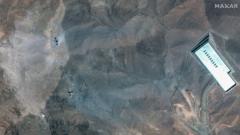In just 24 hours, escalating military actions and diplomatic negotiations resulted in a ceasefire between Iran and Israel, following significant attacks and warnings involving military bases in Qatar. Both nations expressed their positions amid the backdrop of a volatile conflict, highlighting the intricate dynamics of the Middle East.
Unraveling Tensions: The 24-Hour Path to a Middle East Ceasefire

Unraveling Tensions: The 24-Hour Path to a Middle East Ceasefire
A tumultuous sequence of events led to a fragile ceasefire between Iran and Israel, shaped by U.S. diplomatic efforts and military actions.
The recent escalation in the Middle East, characterized by intense military actions and diplomatic maneuvering, culminated in a hastily negotiated ceasefire between Iran and Israel within a dizzying 24-hour window. Following Israel's significant strikes targeting Iranian military infrastructure and a series of retaliatory missile attacks, tensions soared, prompting urgent responses from key stakeholders, notably the United States.
On June 13, Israel engaged in airstrikes against various Iranian locations, heightening the risk for U.S. citizens in the region. The U.S. government promptly advised its citizens in Qatar to "shelter in place," anticipating potential retaliation from Iran against the strategically significant al-Udeid air base in Qatar, housing thousands of U.S. troops. Amidst growing apprehension, Iran's Supreme Leader, Ayatollah Ali Khamenei, seemingly directed his forces to retaliate against American assets.
As the day progressed, indications of an imminent missile attack against the al-Udeid base became apparent. Both U.S. and Qatari officials prepared for the worst, closing airspace to incoming flights and evacuating military personnel. Despite the foreboding atmosphere, Iranian attacks, while initially generating media hype, led to no casualties due to effective interception by defense systems, suggesting a calculated response aimed at avoiding significant escalation.
By mid-afternoon, U.S. President Donald Trump shifted from a defensive posture to a surprisingly conciliatory tone, suggesting that Iran's actions were not retaliatory in strength but instead reflective of vulnerabilities. He extended an olive branch for potential peace, igniting speculation about a ceasefire agreement amid swirling reports of behind-the-scenes diplomatic negotiations.
The situation reached a critical juncture when both nations launched missiles and airstrikes as the ceasefire agreement began to materialize. While Iranian missiles targeted populated areas in Israel, Israeli forces carried out operations in Iran, culminating in both parties issuing conflicting statements regarding ongoing hostilities. Nevertheless, diplomacy appeared to take precedence as Trump announced via social media the establishment of a ceasefire agreement just as military actions intensified.
Despite the tentative grasp on peace, the truce faced immediate threats with missile launches from both nations shortly after Trump's declaration. In the chaos, the American president urged restraint from both parties, expressing dissatisfaction with their reactions, emphasizing the fragility of the situation.
As international observers closely monitored the evolving scenario, the day's events underscored the complexities of Middle East geopolitics and the perennial challenge of maintaining peace amidst deep-rooted rivalries.























